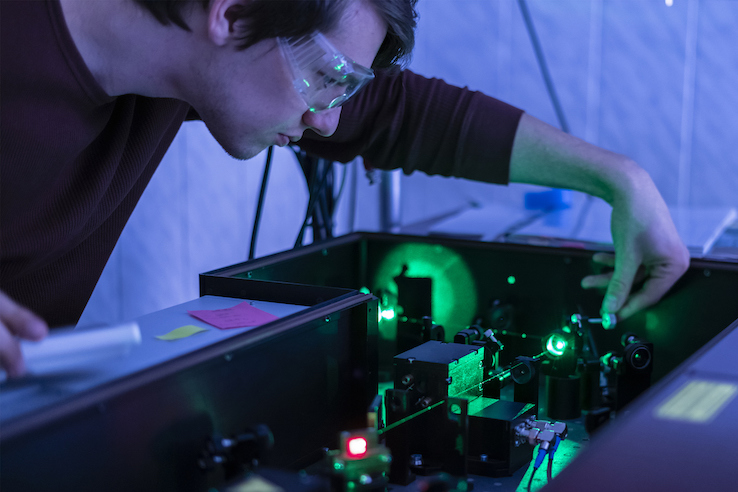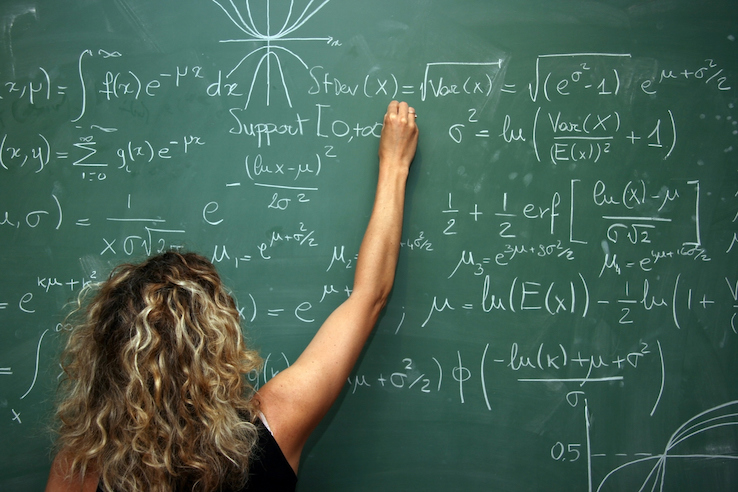Physical Science Skills Worksheet Answers

If your mind thinks it needs to start questioning everything information technology knows when you hear the phrase "quantum physics," you're not alone. For many of us, just a mention of breakthrough physics might bring up visions of incalculable math equations lining a vast chalkboard like wallpaper or tiny atoms performing an electrically charged ballet deep inside, well, everything on World. We might imagine genius scientists poring over labwork or accidentally discovering the keys to teleportation during routine inquiry. Only you don't have to be a genius to gain a working knowledge of what breakthrough physics is — it's a lot more than accessible than we're led to believe in the media. Join the states every bit we intermission information technology down in simple, like shooting fish in a barrel-to-comprehend language.
What Is Quantum Physics?
In the simplest terms possible, quantum physics, also known as quantum mechanics, is a branch of science that studies things that are very, very small — tiny particles that, together, make upwards everything around us. This co-operative of physics doesn't only settle for studying how things work on the surface. Quantum physicists want to know how matter behaves at the level of atoms and molecules, which are nearly as small as things get.
On the one mitt, quantum physics deals with what's happening all around us every day. The entire universe, ourselves included, is made up of tiny atoms and particles that are continually in motion and performing actions, whether we think about them or non. On the other hand, nigh of united states don't really tend to think of things on the quantum level, as atoms and particles require powerful scientific instruments to observe. This is part of why quantum physics can seem and so mind-boggling.
It wasn't until the development of loftier-tech scientific tools that quantum physics really began to sally as a science itself. It was ushered in during the early on 20th century with the work of scientists similar Max Planck and Neils Bohr, who are considered the founding fathers of Quantum Theory. Albert Einstein doesn't rank far behind, as he won a 1921 Nobel Prize for his theory of Photoelectric Upshot, which profoundly contributed to Quantum Theory equally physicists empathise it today.
Simply why written report it in the get-go place? There's a reason that smartphones and computers didn't exist before scientists really began to wrap their heads around quantum physics. Everything from modernistic computer chips to lasers, MRI machines, modernistic telecommunication devices and GPS signals simply could not be without our modern agreement of quantum mechanics.

Another reason why quantum physics can seem complicated, even to physicists, is that things can become confusing at a quantum level. Most of us empathize reality every bit described by the laws of classical mechanics, which were pioneered past Issac Newton. These principles tell us that objects exist in a specific place and at a specific time.
The play tricks is that when you intermission things down to a breakthrough level, the laws of classical mechanics don't apply. At this small level, some things exist in a state of probability — they might exist at either point A or point B. But what exactly does that mean?
Imagine, for instance, that someone brings yous into a room where there are two identical boxes on a table. In i box, at that place'south a check for $1 million. In the other, in that location's a check for $1. They and then inquire you lot to tell them the location of the $1 million check without opening either box.
While this state of affairs would feel frustrating to the average person, on principle, it's the kind of dilemma quantum physicists aim to work out. Often, at the breakthrough level, they have to sympathize tiny objects in terms of probability. Because the laws of what most people understand as reality are a flake unlike in quantum mechanics, they tin can exist hard to picture in our heads. Sometimes, they're all-time described using mathematical equations.
What Are Some Common Principals of Breakthrough Physics?

While it's probably not surprising that it could take years of study to catch up with virtually quantum physicists, it is possible to get a broad overview of some of the core concepts of this branch of scientific discipline. Let's look at a few defining principles that have emerged from the report of quantum physics.
Moving ridge-Particle Duality
Wave-particle duality is a major concept in the world of quantum physics. It centers on the fact that some objects can appear to be both a particle and a wave at the same fourth dimension. I mode to imagine this concept is to picture a ball, which in this example represents an electron.
Say that you toss the ball into a lake and it disappears but creates a serial of ripples, which represent waves in this metaphor. Perhaps a second later, the ball pops support to the surface, surrounded past the ripples. Are yous looking at a particle or a wave? The simplest answer is both, which is the general idea behind wave-particle duality and the fact that sometimes yous accept to utilise both terms to fully draw what's happening, fifty-fifty if they might sound alien.
Breakthrough Superposition
Another interesting concept is the idea of breakthrough superposition, which focuses on the idea that an object like an electron can be in ii breakthrough states at the aforementioned time. To be more than specific, let's utilise the fact that electrons can have an "up spin," which ways they're spinning upwards, or a "downward spin," which ways they're spinning down.
Until a detail electron is measured, there's an infinite possibility it could exist spinning in either management. Retrieve of it as a spinning quarter. Is the quarter heads or tails while it's spinning? Technically both and neither until information technology stops and someone can measure the results.
Quantum Entanglement
Breakthrough entanglement is a phenomenon that tin can happen when two particles interact in a certain way that causes them to become linked. From that point on, they'll always oppose each other, so one volition always have an up spin while the other volition always accept a downward spin.
One time this linkage has occurred, these two particles will always maintain opposing states, no matter how far apart they are. To put this into perspective, think of information technology this way: It means that if you knew the spin of one electron on Earth, you could immediately discover the spin of the electron it was entangled with, even if it was in a afar galaxy light-years abroad. This information could be obtained faster than the speed of low-cal — a concept that entertained Einstein to the point he nicknamed it "spooky action at a altitude."
Physical Science Skills Worksheet Answers,
Source: https://www.reference.com/science/quantum-physics-made-simple?utm_content=params%3Ao%3D740005%26ad%3DdirN%26qo%3DserpIndex&ueid=99521c13-07eb-4abd-853c-a3156209321b
Posted by: taylorbeening.blogspot.com


0 Response to "Physical Science Skills Worksheet Answers"
Post a Comment